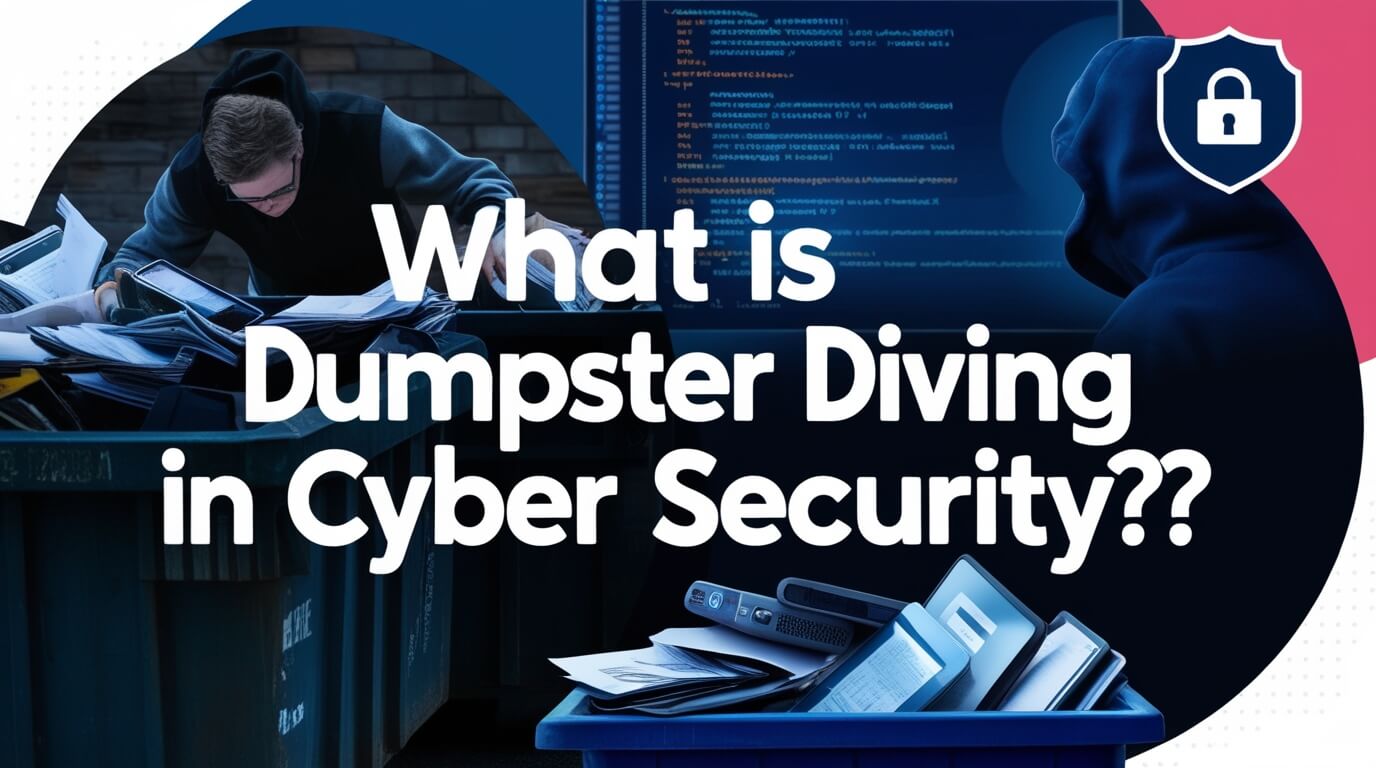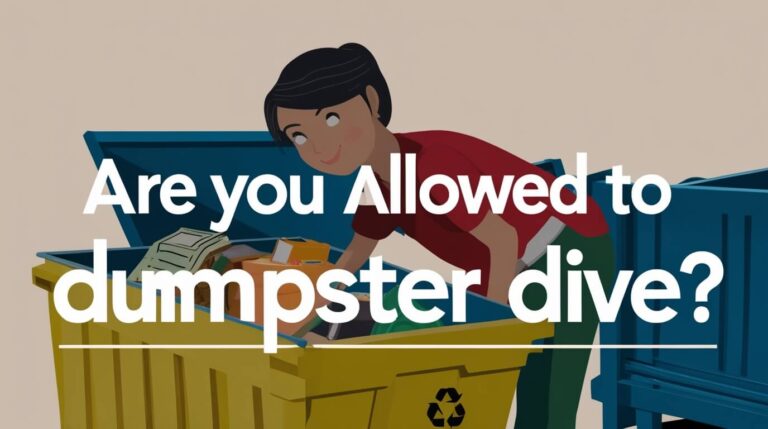
Dumpster diving in cyber security involves searching through physical and digital waste to find sensitive information. This method is often used by cybercriminals to gather data that can be exploited for various malicious activities, such as identity theft, corporate espionage, and more. But what exactly does dumpster diving entail, and how can you protect yourself and your organization from this type of threat?
In this detailed blog post, we will explore what dumpster diving is, how it works, the types of information attackers look for, real-life examples of dumpster diving attacks, and most importantly, how to safeguard against it. By the end of this post, you’ll have a comprehensive understanding of dumpster diving in cyber security and practical strategies to protect sensitive information.
Understanding Dumpster Diving in Cyber Security
Definition and Concept
Dumpster diving in cyber security is the practice of sifting through waste—both physical trash and digital data—to find valuable information. This can include anything from old documents and hard drives to discarded emails and deleted files. Unlike other cyber attacks that require technical skills to penetrate systems, dumpster diving relies on human error and poor disposal practices.
Cybercriminals find this method appealing because it can yield a wealth of information with relatively low effort and risk. While the term “dumpster diving” might evoke images of individuals rummaging through garbage bins, it also encompasses digital scavenging, where attackers recover deleted files or access improperly disposed of digital storage devices.
History and Origins
The concept of dumpster diving is not new. Before the digital age, espionage, and identity theft often involved physical searches through trash bins to find discarded documents, receipts, and other sensitive materials. As technology evolved, so did the methods of dumpster diving. Today, attackers target both physical and digital waste, making it a versatile technique for data theft.
How Dumpster Diving Attacks Work
Physical Dumpster Diving
Physical dumpster diving involves searching through garbage bins and dumpsters to find valuable items that contain sensitive information. Common targets include corporate offices, medical facilities, and residential areas where people might dispose of documents without shredding them.
Attackers look for:
- Paper documents: Such as bank statements, medical records, and confidential memos.
- Electronic devices: Like old computers, hard drives, and USB sticks that might still contain recoverable data.
- Miscellaneous items: Including personal notes, discarded mail, and any other item that might reveal useful information.
Digital Dumpster Diving
Digital dumpster diving focuses on retrieving information from discarded or poorly managed digital storage. This can involve:
- Recovering deleted files: Using software tools that can restore files thought to be deleted but not properly erased.
- Accessing backup devices: Old backup drives and cloud storage accounts that haven’t been securely wiped.
- Extracting data from devices: Like smartphones, tablets, and laptops that have been discarded without proper data destruction.
Types of Information Sought by Dumpster Divers
Personal Information
Personal information is highly valuable to dumpster divers because it can be used for identity theft and other fraudulent activities. This includes:
- Credit card numbers
- Social security numbers
- Passwords and PINs
- Personal identification documents
Corporate Information
Corporate data is another prime target. Information that can be exploited includes:
- Proprietary data: Trade secrets, business plans, and intellectual property.
- Internal communications: Emails and memos that might reveal company strategies or sensitive negotiations.
- Customer data: Including contact details, purchase histories, and payment information.
Other Valuable Information
Dumpster divers also look for other types of sensitive information that can be used or sold:
- Medical records: Containing detailed health information that can be exploited.
- Financial statements: These can provide insights into personal or corporate finances.
- Legal documents: These might include contracts, litigation details, or other confidential information.
Techniques and Tools Used in Dumpster Diving
Physical Tools and Techniques
Physical dumpster diving requires minimal tools but a keen eye for valuable items. Commonly used tools include:
- Gloves: To protect against hazards while searching through trash.
- Flashlights: For visibility in poorly lit areas.
- Bags: To collect and transport found items.
Techniques often involve:
- Sorting: Separating valuable items from general waste.
- Timing: Targeting trash collection days or times when disposal is likely to happen.
Digital Tools and Techniques
Digital dumpster diving involves more sophisticated tools to recover and access data. These can include:
- Data recovery software: Programs designed to retrieve deleted files.
- Forensic tools: Used to analyze and extract data from digital devices.
- Password cracking tools: For accessing protected files or accounts.
Real-Life Examples of Dumpster Diving Attacks
Jerry Schneider Case
Jerry Schneider, a former computer programmer, famously used dumpster diving to gather sensitive information. Schneider exploited weaknesses in how companies disposed of their data, collecting documents and electronic waste that contained valuable information. His activities highlighted the risks associated with improper data disposal.
Matt Malone’s Findings
Matt Malone, a security expert, has turned dumpster diving into a hobby to demonstrate the vulnerabilities in data disposal practices. He has uncovered everything from confidential corporate documents to personal information, emphasizing how easily sensitive data can be exposed.
Larry Ellison’s Investigation
In the corporate world, Larry Ellison, co-founder of Oracle, used dumpster diving tactics to gather information on competitors. This case showed how dumpster diving can be part of corporate espionage, leading to significant strategic advantages for businesses willing to exploit these methods.
Consequences of Dumpster Diving Attacks
Personal Consequences
For individuals, the consequences of dumpster diving can be severe:
- Identity theft: Leading to financial loss and legal complications.
- Privacy invasion: Exposure of personal details and private life.
- Financial loss: Fraudulent transactions and credit damage.
Corporate Consequences
For businesses, the impacts can be even more significant:
- Data breaches: Resulting in loss of sensitive company and customer data.
- Financial and reputational damage: Eroding trust and causing financial losses.
- Legal repercussions: Including fines and lawsuits for failing to protect sensitive information.
Prevention Strategies for Dumpster Diving
Proper Disposal of Physical Documents
One of the most effective ways to prevent dumpster diving is to ensure that physical documents are properly disposed of:
- Shredding: Use cross-cut shredders to destroy documents containing sensitive information.
- Secure trash bins: Lockable bins can prevent unauthorized access to discarded materials.
Secure Disposal of Digital Data
For digital data, proper disposal is crucial:
- Wiping hard drives: Use software to securely erase data before discarding devices.
- Data destruction services: Professional services can ensure that digital storage devices are destroyed.
Employee Education and Policies
Educating employees and implementing strict disposal policies can significantly reduce the risk of dumpster diving:
- Training: Regularly train employees on the importance of proper data disposal.
- Policies: Establish and enforce policies for secure data disposal and document management.
- Audits: Conduct regular audits to ensure compliance with data disposal practices.
Role of Cyber Security Tools in Preventing Dumpster Diving
Data Loss Prevention (DLP) Solutions
DLP solutions are designed to detect and prevent data breaches:
- Monitoring and controlling data: DLP tools can track data movement and prevent unauthorized access.
- Examples: Popular DLP tools include Symantec DLP, McAfee Total Protection, and Forcepoint DLP.
Encryption Technologies
Encrypting sensitive data adds an extra layer of protection:
- Data encryption: Ensures that even if data is recovered, it cannot be read without the decryption key.
- How it works: Encryption tools like BitLocker, VeraCrypt, and FileVault can protect both stored and transmitted data.
Monitoring Software
Monitoring software can help detect and prevent suspicious activities:
- Real-time monitoring: Tools like SolarWinds and Splunk provide real-time insights into data access and movement.
- Incident response: These tools can alert administrators to potential breaches, allowing for quick action.
Best Practices for Individuals and Organizations
Tips for Individuals
To protect personal information, individuals should:
- Manage personal data: Regularly review and securely dispose of outdated documents.
- Use shredders: Shred all documents containing personal information before disposal.
- Be cautious with digital devices: Ensure that digital devices are properly wiped before disposal.
Tips for Organizations
Organizations can adopt several best practices to enhance data security:
- Implement robust security policies: Establish clear guidelines for data handling and disposal.
- Regular training: Conduct training sessions to keep employees informed about security practices.
- Conduct audits: Regularly audit data disposal practices to ensure compliance.
Final Thoughts
Dumpster diving remains a significant threat to cyber security. Understanding the risks and implementing preventive measures can significantly reduce the chances of sensitive information falling into the wrong hands. By staying informed and vigilant, both individuals and organizations can protect themselves from the potential consequences of dumpster diving.
Remember, proper data disposal is not just a best practice; it’s a critical component of maintaining security and privacy in today’s digital world.






